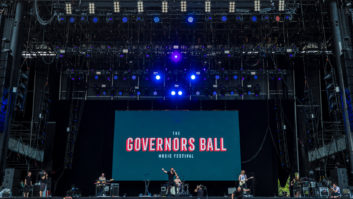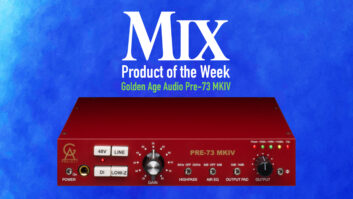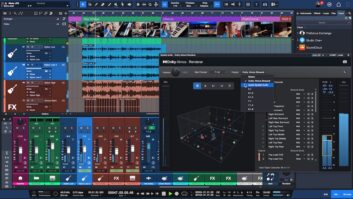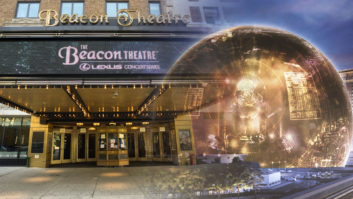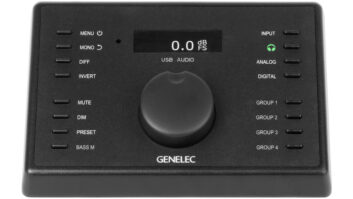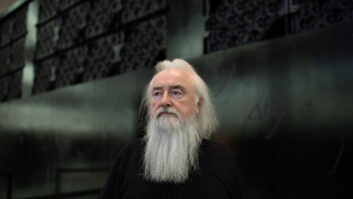
New York, NY—Queens of the Stone Age, Palm Desert’s biggest band led by the charismatic Joshua Homme, kicked off a tour in the summer of 2017 in support of its seventh studio album, Villains. Evident in its effect-heavy production courtesy of Mark Ronson, the collection is more disco inferno than the group’s usual mid-tempo but still brings Queens’ signature hard-rocking heat. The tour culminated in October at Madison Square Garden in New York City, creating a new highwater mark for the band’s touring successes to date; it also was the band’s final U.S. show before heading to Europe a week later.
With assistance from Eighth Day Sound, the U.S. tour leg stopped at every size venue imaginable, from large sheds, theaters and TV studios to arenas and festivals filled by small armies of fans. “It’s all fun; no show is identical, so it keeps it interesting to say the least,” said Spencer Jones, monitor engineer for the tour, speaking at the Garden.
As such, one of the biggest challenges was getting the band’s mixes to sound as consistent as possible for each performance. On tour with the group for the first time but no stranger to the music, Jones met this head-on with an arsenal of, while minimal, versatile gear. Jones cited his stageside DiGiCo SD7 console as a key component in his setup.
“The SD7 is bigger and you’ve got a ton of control right at your fingertips—multiple screens, inputs on each side and two sets of main faders, which I find particularly convenient. For example, I have the main output faders on the bottom, effects and VCAs on top, making moves quicker,” says Jones.
All the effects on the new album meant that that flexibility with changing cues allowed Jones to react quickly to high-energy transitions between material new and old. Jones typically works as a FOH engineer, but as a monitor engineer, his five clients (aka the band members) are the most discerning listeners in the room. As such, he finds reactive—and ideally proactive—changes are especially important in such a situation.
“Josh has a great ear and has some specific requests, but he knows the language and is great at communicating with a sound engineer,” said Jones. “I think it’s important for monitor engineers to think of themselves as an extension of the stage. For me, it was about finding the right gain structure and learning what each member of the band likes to hear, preempting a change before they even needed to think about it.”
Jones used Shure PSM 1000 in- ear monitors for all five band members, but mixes were also conveyed via d&b audiotechnik V8s used as sidefills, J-SUB subwoofers and a drum subwoofer.
Over at the side of the stage, Jones used a minimum of onboard effects, and nearby racks sported a Bricasti M7 for use as his main reverb and a Thermionic Culture Vulture was essential for capitalizing on several songs’ distortion. Meanwhile, a pair of Eventide Eclipses were also in the setup, one designated for use as a doubler at all times and the other as a flanger for the chorus on the effect-heavy Villains opener, “Feet Don’t Fail Me.” An Eventide Reverb 2016 and a Demeter Amplification RV-1D Real Spring Reverb rounded out the core rig.
“I personally requested an Empirical Labs Distressor for the main mic,” says Jones. “It’s a great compressor and an ideal solution for keeping your vocal in check at all times. It’s always one of the first two items I pick. We use a lot of Telefunken mics—M80s on all vocals, M81s on a lot of the guitars, an SM7 on one of the guitar channels and a variety of drum mics like the Earthworks DP30/C, AKG 414s and Neumann 184s”
FOH engineer Stewart Bennett had a preference for many of the microphones, and Jones worked closely with him, especially during the rehearsal phase. While manning the monitors can be a demanding role with an extra dose of responsibility, Jones has been making the most of it.
“It’s been really fun; I can almost treat it as a FOH gig and act on my own instead of waiting for a musician to ask to turn it up or down first,” says Jones. “I factor in my interpretation of the music and their preferences, and then get their signoff on the way it should sound…. It makes the job more fun to get acquainted in such a way, especially when you dig the tunes.”
Eighth Day Sound • 8thdaysound.com
DiGiCo • digico.biz
